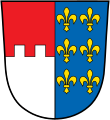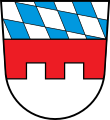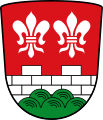Preysing (noble family)
Preysing is the name of an old Bavarian noble family . The widely ramified family rose to the rank of baron and imperial count . Family members have achieved great dignity in many areas of society.
history
origin

The family first appears in a document around 1100 with Gerunch de Prisingan and around 1120/40 in the Erding and Landshut area . The trunk series begins around 1135–1160 with Adalhart de Prisingen . Name bearers appear as ministerials in the wake of the Wittelsbachers . The oldest headquarters was Langenpreising , and the move to Kronwinkl Castle near Eching (Landshut district) , which is still owned by the family today , took place at an early stage.
As early as the second half of the 12th century, the Preysing held important court offices in the duchies of Upper and Lower Bavaria . In the first half of the 14th century you received the inheritance office for both areas.
The Cistercian abbey of Seligenthal was an important burial place for the family until the 17th century , where the family also had two abbesses . In the Frauenkirche in Munich there is a death shield of a Count von Preysing from the 19th century.
Lines
The Wolnzach line was raised to the baron status in 1465 , but died out shortly afterwards in 1497. The Hohenaschau line with the rule Hohenaschau and the rule Wildenwart was elevated to the status of imperial count in 1664 , it died out in 1853. The Moos line was raised to the imperial baron status in 1607, to the imperial count status in 1645 and expired in 1836. The Lichtenegg line received the count's diploma in 1766 and, from 1818, the hereditary imperial council dignity . The Preysing-Lichtenegg lines and the resulting Preysing-Lichtenegg-Moos line still exist today.
Former possessions
In addition to the headquarters of Langenpreising and Kronwinkl, the possessions included :
Wolnzach (1266–1482), Fußberg Castle with the Grubmühl in Gauting (14th century to 1420), the Bailiwick of Feilnbach with Halsbach and Feichten an der Alz (until 1406), Heidenkam (from the beginning of the 14th century), Unterweikertshofen ( 1380–1410 and 1635–1706), Roggenstein Castle (14th century), Zinneberg Castle (1332–1350), the Vogtei zu Wald (= Osterwaal near Au / Hallertau), Au Castle (Hallertau) (1385–1472 and 1764–1828), Förnbach (15th century), the Hofmark Kopfsburg (15th century - 1628), Moos Castle (1568–1940) with Natternberg (1802–1836), Lichtenegg Castle (1580–1662), Unter-Falkenstein Castle (Flintsbach am Inn) (16th century), Riedering (?), The Hohenaschau lordship with Hohenaschau Castle and Bernau am Chiemsee (1602–1853), Neubeuert Castle (1668 – approx. 1860), the Saldenburg (1677–1826), Ramsberg Castle (Donzdorf) (1732–1809), Reichersbeuern Castle , also called Sigriz Castle, (1627–1820), Rechberghausen (1746–1789), Ast mit Tiefenbach (1756–1774), Wildenwar Castle t (1771–1862), Hohenkammer Castle (1804–1821), Schlachtegg Castle (19th century) Century), Hechendorf (? -?). In Erding, Johann Warmund Freiherr von Preysing-Moos (1567–1648) built the Grafenstock (today's Erdinger Town Hall) as the city residence . In Munich, the family built Palais Preysing in Residenzstrasse at the beginning of the 18th century , and later they also acquired Palais Neuhaus-Preysing, built in 1737 in Prannerstrasse.
In the 18th century the family belonged to the most important families of the Bavarian nobility. Because of the possession of Ramsberg Castle (Donzdorf) (acquired in 1732) and Rechberghausen (acquired in 1746), the Lords of Preysing were temporarily members of the Imperial Knighthood in the knight canton of Kocher of the Swabian knight circle in the 18th century .
The origin of the District Court of Kling is linked to the name Preysing in 1321. Likewise, the Fronte Preysing (Fronte 79) of the Ingolstadt state fortress .
Moos Castle (owned by the family from 1568–1940)
Lichtenegg Castle (1580–1662)
Hohenaschau Castle (1602-1853)
Neubeu Castle (1668 – approx. 1860)
Saldenburg (1677-1826)
Grafenstock in Erding (built at the beginning of the 17th century)
Altes Palais Preysing , Residenzstrasse in Munich (built at the beginning of the 18th century)
Palais Neuhaus-Preysing , Prannerstrasse in Munich
Personalities

- Johann Christoph von Preysing (1576–1632), statesman, memorial plaque in the Munich Hall of Fame
- Johann Franz von Preysing (1615–1687), Bishop of Chiemsee 1670–1687
- Max Ferdinand Graf von Preysing (1655–1739) was the chief steward of Elector Maximilian II. Emanuel , see also Preysing Column
- Maximilian Graf von Preysing-Moos (1760–1836), Major General of the Bavarian Army in the Russian campaign in 1812
- Johann Friedrich Graf von Preysing (1769–1812), Colonel and Commander of the 10th Line Infantry Regiment “Junker”, died in 1812
- Johann Maximilian IV. Emanuel von Preysing (1687–1764), politician, chief steward
- Johann Siegmund Graf von Preysing-Hohenaschau, Lieutenant General in the Seven Years War 1751/59, see also 10th Royal Bavarian Infantry Regiment "King Ludwig"
- Karl Graf von Preysing, Baron von Altenpreysing called Kronwinkl (1767–1827), Member of the Bavarian State Parliament
- Conrad von Preysing (1843–1903) was a member of the Reichstag, see also Preysing Memorial
- Hedwig von Preysing (1849–1938) was active in the field of charitable work
- Johann Graf von Preysing, epitaph from Ignaz Günther 1771/72
- Johann Kaspar von Preysing -Lichtenegg-Moos (1844–1897) was a member of the German Reichstag.
- Max von Preysing-Lichtenegg (1849–1926), landowner and member of the German Reichstag
- Christiane von Preysing (1852–1923) was active in the field of charitable work
- Konrad Graf von Preysing (1880–1950) was bishop of Eichstätt and Berlin , later a cardinal and a staunch Nazi opponent
- Georg von Preysing, Mayor of Gmund am Tegernsee from 2000–2018
coat of arms
The family coat of arms is divided by two battlements of red and silver. The helmet covers are black and silver. The crest consists of a gold-crowned green parakeet with a red collar between two buffalo horns in silver and red, of which the right outside is studded with six black, the left with six silver clover leaves.
The helmet decoration is described in this way in a coat of arms of Emperor Maximilian I from 1497. However, the leaves are missing from many coats of arms. There is a multiple coat of arms, which takes up the original coat of arms in a crossing in two fields.
Historical coats of arms
Coat of arms in Scheibler's book of arms from 1450–1480
Coat of arms in Siebmacher's coat of arms book from 1605
Preysing coat of arms in municipal and district coats of arms
Coat of arms of the municipality of Langenpreising
Coat of arms of the Landshut district
Coat of arms of the municipality of Eching
Coat of arms of the municipality of walls
Coat of arms of the municipality of Pastetten
Coat of arms of the Saldenburg community
Coat of arms of the municipality of Birgland
Coat of arms of the municipality of Moos
See also
literature
- Otto Hupp : Munich calendar 1900. Buch u. Art Print AG, Munich / Regensburg 1900.
- Genealogical manual of the nobility , Adelslexikon Volume XI, Volume 122 of the complete series, CA Starke Verlag, Limburg (Lahn) 2000, ISSN 0435-2408
- Margit Ksoll-Marcon , Stephan Kellner: Preysing, von. In: New German Biography (NDB). Volume 20, Duncker & Humblot, Berlin 2001, ISBN 3-428-00201-6 , pp. 713-715 ( digitized version ).
Web links
- Genealogy of the family on the homepage of the Lichtenegg Castle Ruins Association
- History of the family on the homepage of the HdBG
- History of the Preysinger on the homepage of the Wolnzach market
- Entry about Preysing in New General German Adels Lexicon
- Coat of arms of the “Preysinger” in the Book of Arms of the Holy Roman Empire , Nuremberg around 1554–1568
Individual evidence
- ^ Peter Acht, Die Traditions des Klosters Tegernsee, Munich 1952, pp. 101 ff, no. 131a
- ↑ Archived copy ( Memento of the original from April 22, 2009 in the Internet Archive ) Info: The archive link was inserted automatically and has not yet been checked. Please check the original and archive link according to the instructions and then remove this notice.
- ↑ Epitaph from 1697 in the church: http://www.kirchenundkapellen.de/kirchenpz/unterweikertshofen.php
- ^ Gerhard Köbler : Historical Lexicon of the German Lands. The German territories from the Middle Ages to the present. 7th, completely revised edition. CH Beck, Munich 2007, ISBN 978-3-406-54986-1 , p. 541.
- ↑ http://www.schloss-zinneberg.de/schlossgeschichte.html
- ^ Book of arms of the Westphalian nobility, Book 1, p. 100




















